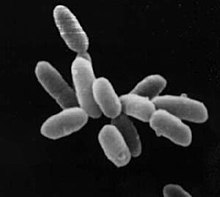| Haloarchaea | |
|---|---|

| |
| Halobacterium sp. strain NRC-1, each cell about 5 µm in length. | |
| Scientific classification | |
| Domain: | |
| Kingdom: | |
| Phylum: | |
| Class: | Halobacteria Grant et al. 2002
|
| Order | |
| Synonyms | |
| |
Haloarchaea (halophilic archaea, halophilic archaebacteria, halobacteria)[1] are a class of prokaryotic organisms under the archaeal phylum Euryarchaeota,[2] found in water saturated or nearly saturated with salt. Halobacteria are now recognized as archaea rather than bacteria and are one of the largest groups. The name 'halobacteria' was assigned to this group of organisms before the existence of the domain Archaea was realized, and while valid according to taxonomic rules, should be updated.[3] Halophilic archaea are generally referred to as haloarchaea to distinguish them from halophilic bacteria.
These microorganisms are among the halophile organisms, that require high salt concentrations to grow, with most species requiring more than 2.0M NaCl for growth and survival.[4] They are a distinct evolutionary branch of the Archaea distinguished by the possession of ether-linked lipids and the absence of murein in their cell walls.
Haloarchaea can grow aerobically or anaerobically. Parts of the membranes of haloarchaea are purplish in color,[5] and large blooms of haloarchaea appear reddish, from the pigment bacteriorhodopsin, related to the retinal pigment rhodopsin, which it uses to transform light energy into chemical energy by a process unrelated to chlorophyll-based photosynthesis.
Haloarchaea have a potential to solubilize phosphorus. Phosphorus-solubilizing halophilic archaea may well play a role in P (phosphorus) nutrition to vegetation growing in hypersaline soils. Haloarchaea may also have applications as inoculants for crops growing in hypersaline regions.[6]
- ^ Fendrihan S, Legat A, Pfaffenhuemer M, Gruber C, Weidler G, Gerbl F, Stan-Lotter H (August 2006). "Extremely halophilic archaea and the issue of long-term microbial survival". Re/Views in Environmental Science and Bio/Technology. 5 (2–3): 203–218. doi:10.1007/s11157-006-0007-y. PMC 3188376. PMID 21984879.
- ^ Cite error: The named reference
NCBIwas invoked but never defined (see the help page). - ^ DasSarma P, DasSarma S (May 2008). "On the origin of prokaryotic "species": the taxonomy of halophilic Archaea". Saline Systems. 4 (1): 5. doi:10.1186/1746-1448-4-5. PMC 2397426. PMID 18485204.
- ^ DasSarma S, DasSarma P (2017). "Halophiles". eLS. John Wiley & Sons, Ltd. pp. 1–13. doi:10.1002/9780470015902.a0000394.pub4. ISBN 9780470015902.
- ^ DasSarma S, Schwieterman EW (2018). "Early evolution of purple retinal pigments on Earth and implications for exoplanet biosignatures". International Journal of Astrobiology. 20 (3): 241–250. arXiv:1810.05150. doi:10.1017/S1473550418000423. ISSN 1473-5504. S2CID 119341330.
- ^ Yadav AN, Sharma D, Gulati S, Singh S, Dey R, Pal KK, et al. (July 2015). "Haloarchaea Endowed with Phosphorus Solubilization Attribute Implicated in Phosphorus Cycle". Scientific Reports. 5: 12293. Bibcode:2015NatSR...512293Y. doi:10.1038/srep12293. PMC 4516986. PMID 26216440.